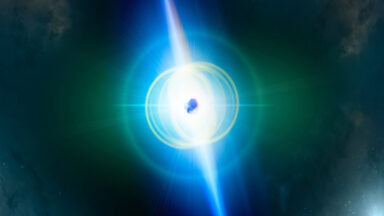Is This a Solution to the Fermi Paradox?

A new theory has been devised on why aliens have never visited Earth, that we know of, as a possible resolution to the Fermi paradox.
Many who are curious about the existence of ETs have heard about the “Fermi paradox,” named after famous astrophysicist Enrico Fermi.
The story goes that in a lunchtime conversation with other astrophysicists who reasoned that, given the vast size and age of the universe it stands to reason, there must be other intelligent life out there, to which Fermi asked, “where is everybody?”
For decades people have tried to answer that question if there are so many possible ET civilizations, where are they? Now, astrobiologists Michael Wong, of the Carnegie Institution for Science, and Stuart Bartlett, of the California Institute of Technology offer their hypothesis, and it’s a bit dark.
Using studies of the growth of cities on Earth, they argue that civilizations grow infinitely but in a finite time. This infinite growth of population and overuse of energy will eventually lead to the death of the civilization or possibly saving themselves.
“We propose a new resolution to the Fermi paradox: civilizations either collapse from burnout or redirect themselves to prioritizing homeostasis, a state where cosmic expansion is no longer a goal, making them difficult to detect remotely.”
So, they argue, if an advanced civilization in space has grown like cities on Earth, they have likely died out. Or if they recognized their dire situation early enough, they may have shifted priorities from interplanetary exploration to planetary survival through homeostasis.
The authors note that this is just a hypothesis and is intended to “provoke discussion, introspection and future work.” Meanwhile, a possible new target in the search for extraterrestrial life has come out of the University of Copenhagen and shows nearly half of sun-sized stars are binary.
Since Earth, the only known planet with intelligent life orbits a single star the sun astronomers have looked for Earth-like planets with a single star in their search for extraterrestrial life. Now professor Jes Kristian Jørgensen, who lead the study, says planetary systems that form around binary stars do so in a way that is much different than around single stars, saying in a statement,
“The result is exciting since the search for extraterrestrial life will be equipped with several new, extremely powerful instruments within the coming years. This enhances the significance of understanding how planets are formed around different types of stars. Such results may pinpoint places which would be especially interesting to probe for the existence of life,”
The discovery was made using the Alma telescopes in Chile of a young binary star about 1,000 lightyears from Earth. The researchers were able to capture the quote, “a snapshot in time of the formation of a binary system” for two nights in 2019. The researchers note that the system is too young for planets to have formed but hope to observe the formation of planetary systems.
“As there is some evidence that planet-formation has already started during the deeply embedded stages studied here, these effects may all be important components for determining the physical and chemical characteristics of the emerging planets.”
And perhaps there we will see evidence of intelligent life in outer space.
Decades After Landing on Mars, We May Find Proof of Past Life

After 25 years of rovers landing on Mars, many are looking forward to the next chapter of Mars exploration, which may include excavating deep into the red planet. In July 1997, NASA’s Pathfinder landed on Mars and began its mission to demonstrate how a robotic rover would land on the red planet.
Using an innovative design, the rover landed on Mars with a parachute and a series of giant airbags to cushion its blow. The Carl Sagan memorial station and the Sojourner Rover outlived their projected lifespan, and in the years following sent magnificent images back to Earth.
The lander returned more than 16,500 images and the rover sent back 550 more, in addition to chemical analyses of rocks, soil, and data on wind and weather. The final transmission from the Mars Pathfinder was on September 27, 1997, but the data it provided helped scientists to conclude Mars was once wet and warm, and rounded rocks on the surface indicate they may have been worn down by running water, and if there was water, there could have been life.
Flash forward to today, NASA’s Perseverance Rover, on the red planet since February of 2021, is tasked with finding past or present life and seeing if humans could one day explore or colonize Mars.


































